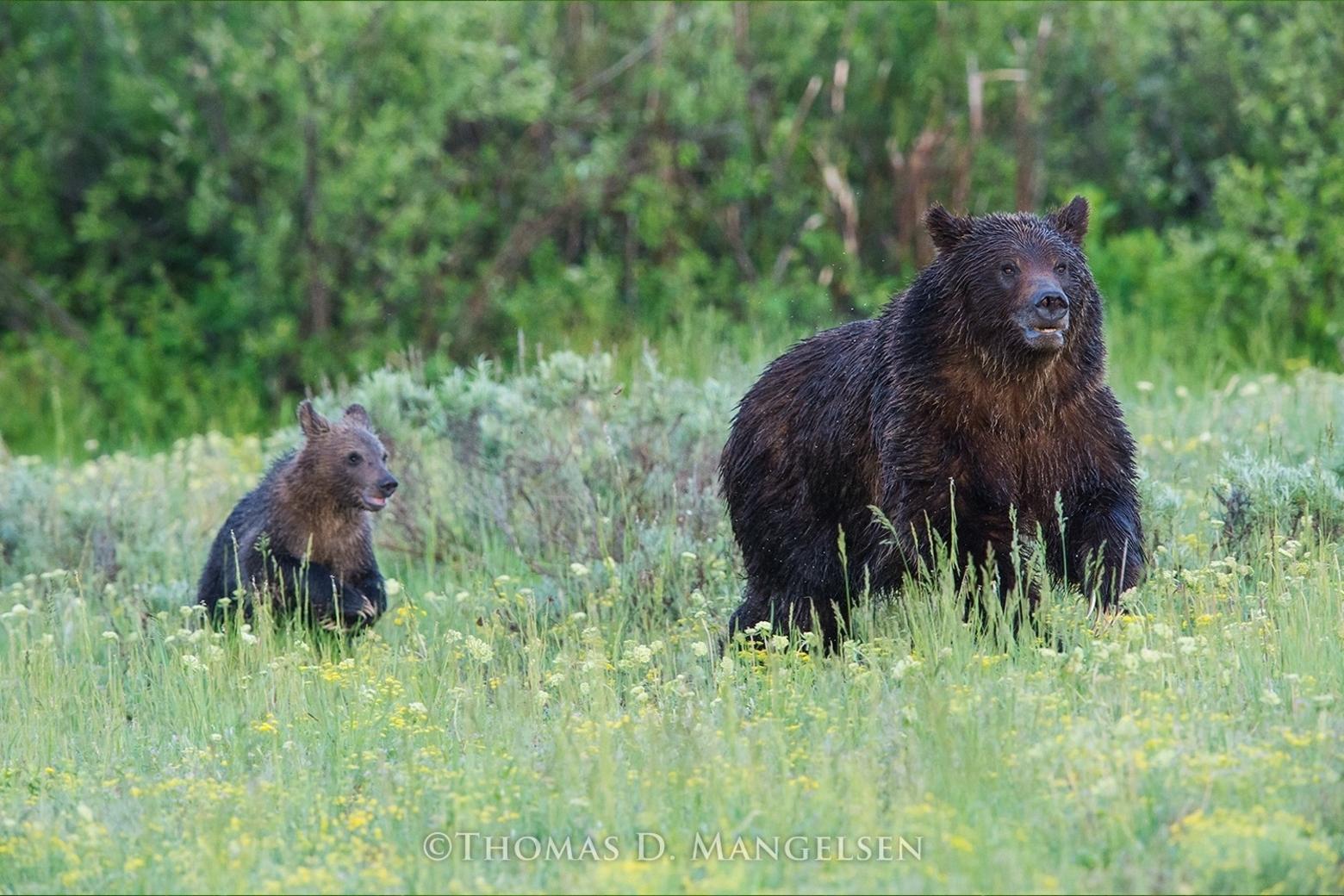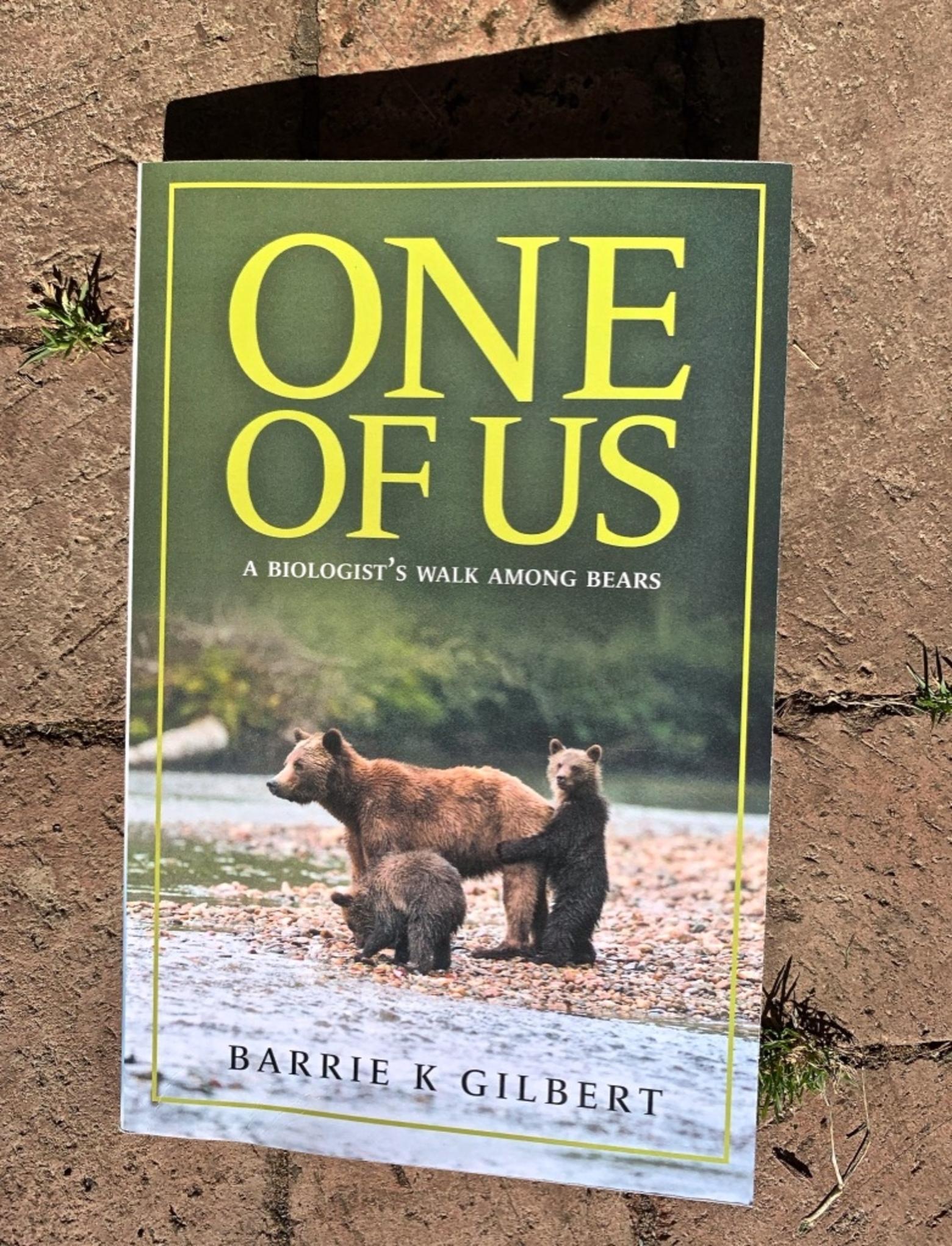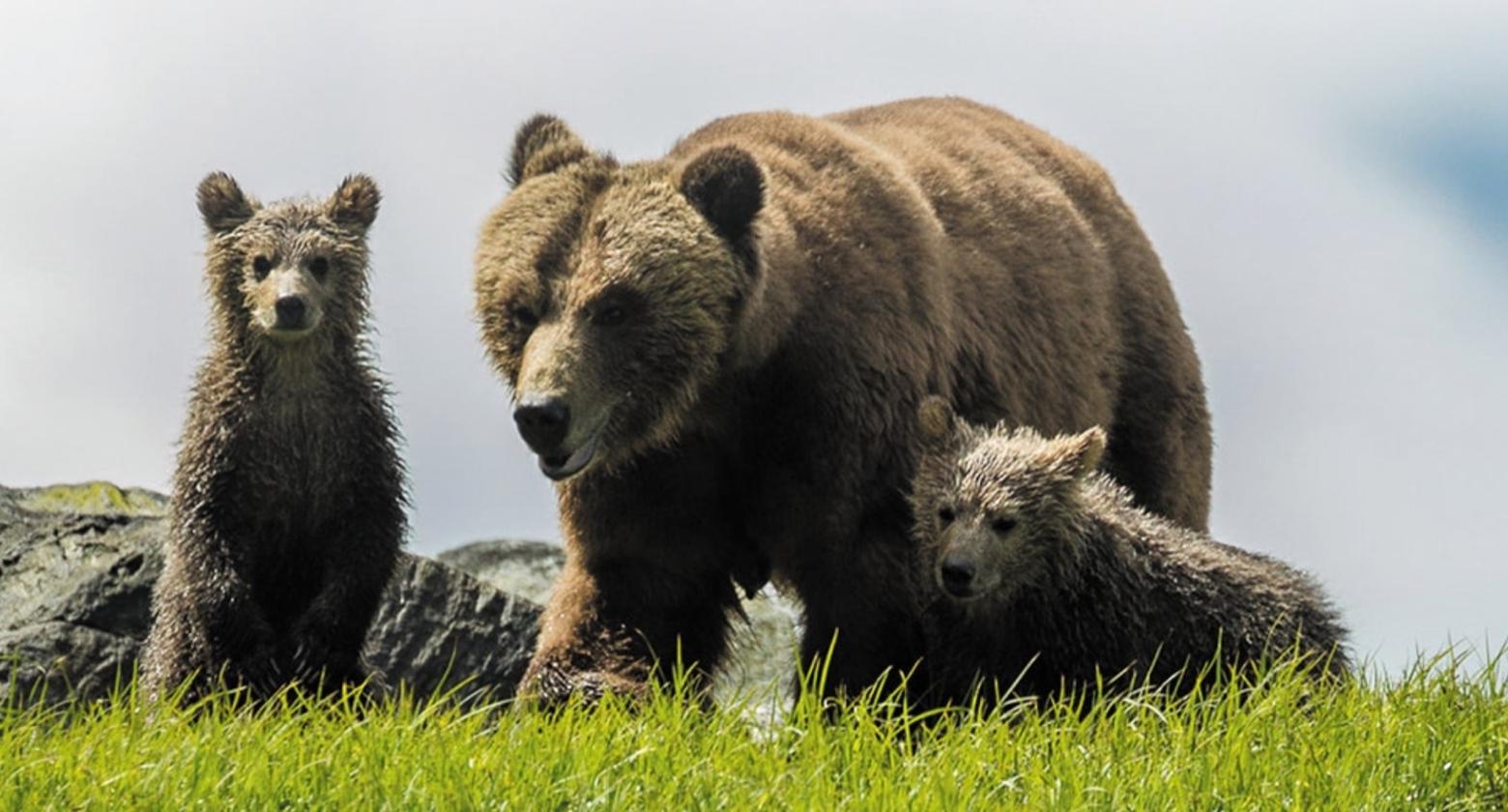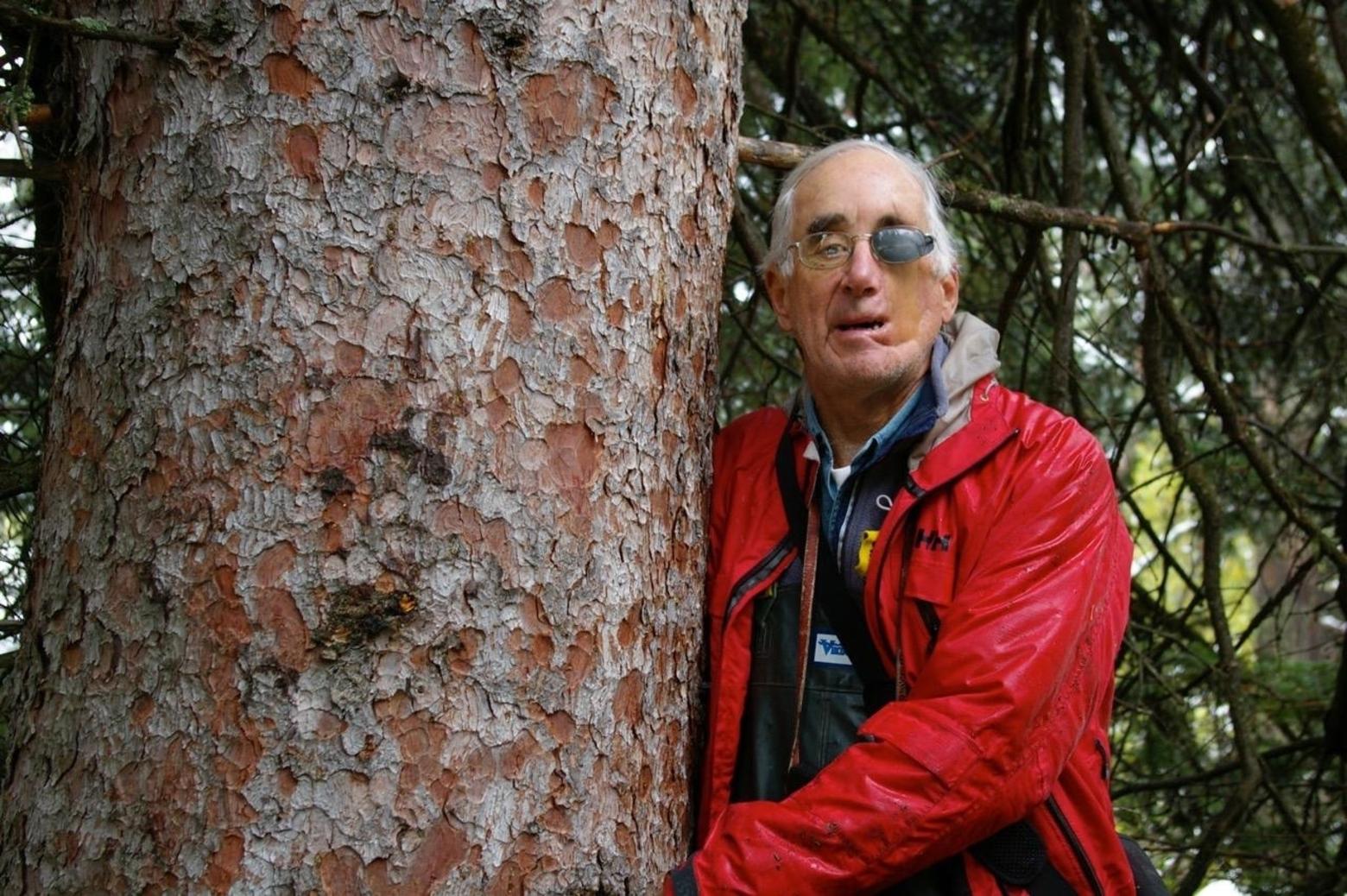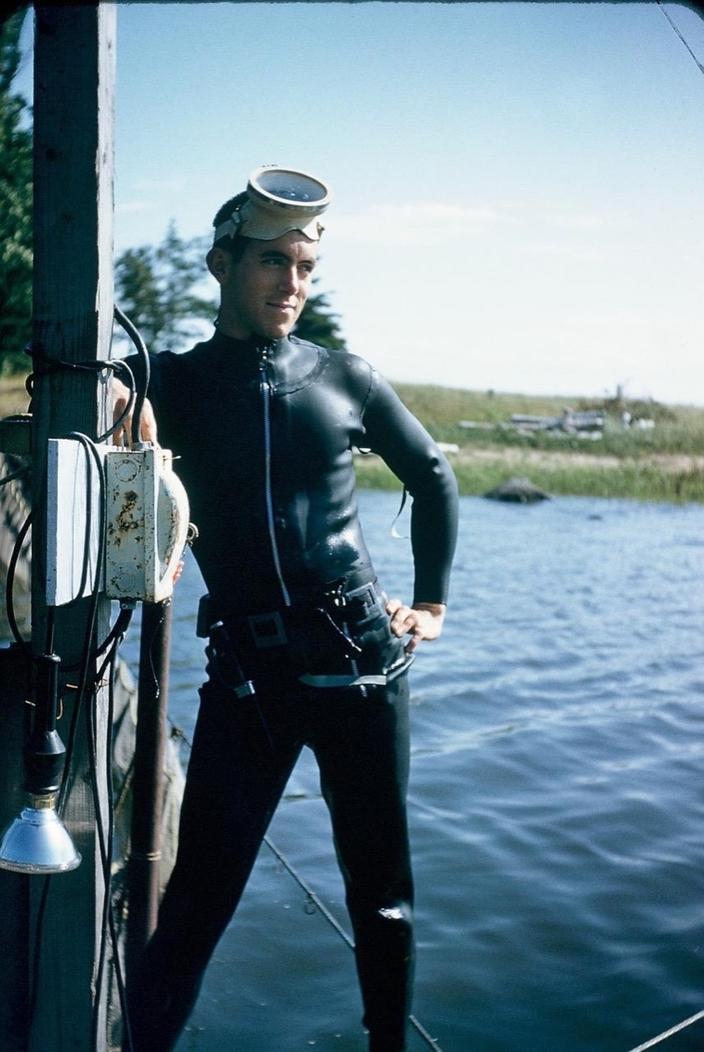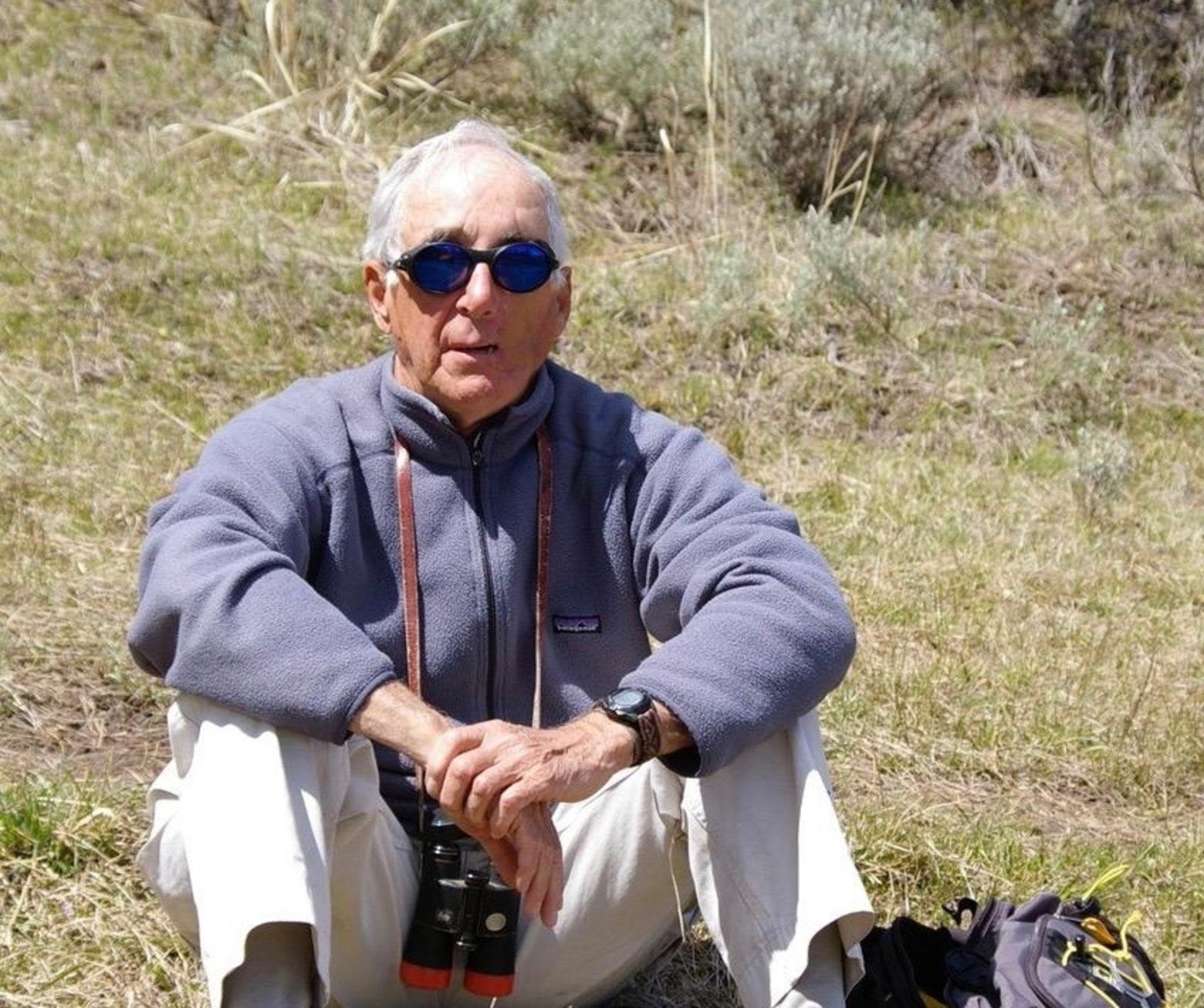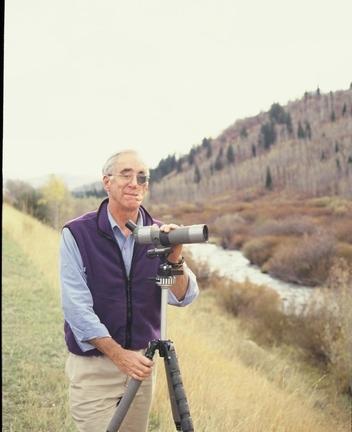Back to StoriesMy Yellowstone Mauling And Mountaintop Rescue: An Exclusive Excerpt
September 2, 2019
My Yellowstone Mauling And Mountaintop Rescue: An Exclusive ExcerptIn his new memoir, 'One of Us,' bear biologist Barrie Gilbert recounts his own brutal grizzly attack and the reasons behind his passion for large landscape conservation
We sighted our first grizzlies at 6:04 a.m. on June 27, 1977.
The day had begun with sunlight chasing a long shadow across an alpine lake far below. We were in the Gallatin River headwaters of northwest Yellowstone National Park, 9,900 feet above sea level. Sitting at the top of the world, my graduate student, Bruce, and I were high with excitement as we watched a mother grizzly and three cubs amble toward a small herd of grazing elk. It was late spring in Montana’s Gallatin Range. The high valleys were greening up, and the long snowdrifts were melting away.
Only a week earlier, we had left Utah State University to begin a study of grizzly bear responses to backcountry hikers and outfitters on packhorses. Finally, bears were in sight, not too far from the well-used Fawn Pass Trail.
The day before, we had hiked from Indian Creek campground, where we loaded up our gear and headed off into the cool, fresh air of America’s most glorious park. Our pace was swift. We had ten miles to go, packing forty-pound loads across rivulets cutting through sagebrush and mud, soon to become dust.
Toward evening, we crested Bighorn Pass. The sun was down, but the solstice twilight lingered as we made camp. Our campsite was well off the trail near a cliff; we were thinking “grizzly” the entire time. Bruce and I pulled dead branches and snags around the tent, thinking it would slow any inquisitive bear and give us time to collect our wits.
Earlier in the week, we had backpacked to low hills overlooking the bison meadows of Pelican Valley for a study site but had come up dry. A canoe trip down Yellowstone Lake to a trout-spawning stream showed more promise: lots of tracks, scats, and fish pieces but no open ground or high spots to observe bears. Still, I loved the remoteness and access by canoe, mostly for aesthetic reasons. In hindsight I envisioned a dream project: research attempting to solve a bear behavior problem that required canoeing deep into the wilderness. A dreamy delusion would be a better description. Separating useful science from preserving wild country has always conflicted me.
Yellowstone offers unique opportunities to see ecological and evolutionary processes closer to pristine conditions than anywhere in the lower forty-eight, including how the behavior of individual animals fits in. This behavioral observation approach was working in Africa with gorillas and lions, so why not here?
Bruce and I shared an interest in animal behavior and psychology as well as woodcraft that would shine later. Bruce was new to the Rockies and cold-water canoeing, but he made up for it with outdoor skills learned in the woods of north Georgia and boundless enthusiasm. His only reticence was canoeing through lightning storms in an aluminum canoe, a bit of wisdom that I failed to fully acknowledge. Lightning strikes can fry a paddler in a metal canoe, another easy way to die in Yellowstone.
We paddled through six thunderstorms, including lightning, hail, rain, and cold fronts that forced us ashore many times. Choppy waves big enough to capsize our canoe forced us to land and huddle under our sturdy vessel. No sooner did each grey-black thunderhead pass than the sun lured us onto the frigid lake once again. This was signature weather in high lakes in the Rockies. We needed another place better suited to see hikers and grizzlies together.
From Bighorn Pass we watched a female with three cubs threaten a big male by chasing him off when he got too close. My notes read, “Cubs stayed very close to female, often at her head, may be feeding on roots dug by mom.” The cubs would be seeking security, wary of the big male, a potential cub killer. Much later I realized the male might also have primed a hair-trigger response in the mother toward me.
We watched those bears for almost two hours until they turned uphill into the timber. Hoping to see them closer, I decided to circle far around and above the family. We left the campsite to hike up the backside of Crowfoot Ridge, emerging on top. There was no trail, just stunted trees. We bushwhacked through fallen snags and heavy tree cover, likely a place nobody but Sheep-Eater Indians or Shoshones had ever stepped.
Near the top of the ridge, we emerged into a more open alpine area.
Leaving Bruce behind for a nature call, I continued ahead, moving briskly over the ridge to avoid being detected by the elk below. I was worried they would bark in alarm if they saw movement against the skyline. I was not even thinking grizzlies, assuming bears would not be at that elevation (9,200 feet).
Bent over and moving over the ridge, I heard an explosive woof and looked up to see a mass of brown fur launch toward me. With milliseconds to react, I faced an insanely furious grizzly, head down, ears back, and roaring. Low to the ground, her body rocketed toward me. I saw her claws raking the bedrock as she accelerated. I knew this was trouble, not a bluff charge. I had to get out of there. Standing to face her never even entered my mind.
This was the furious behavior of a mother protecting her cubs. Later I realized that my fast, low approach probably appeared like I was attacking her. In a state of terror, my only thought was to get away from her. She caught me in seconds and knocked me face down. Her teeth felt like a row of pick-axes scraping across my head as she tore my scalp off. Strangely, I remember no pain despite the furrow that her tooth carved into my skull.
"This was the furious behavior of a mother protecting her cubs. Later I realized that my fast, low approach probably appeared like I was attacking her. In a state of terror, my only thought was to get away from her. She caught me in seconds and knocked me face down."
I turned over to fight her off with my fists. Her second bite came down on my face, a big canine tooth punching into my left eye socket. This is how you die, I thought as I felt bones crunch. One bite removed my cheekbone and sinus, exposing brain membranes. I remember clearly, just before that bite, that her breath smelled rotten, like the bottom of a garbage can on a summer day.
As my life drained onto the ground, I went limp, and the biting stopped. Just then Bruce came over the rise, saw the bear standing on me, and yelled “HAAAA!” as loud as he could.
The bear moved off. Her bloody footprints were later tracked going down the mountain.
Within one hour, eight emergency medical technicians—smoke jumpers from the West Yellowstone Hotshot base—and a helicopter pilot carried out a flawless rescue. While standing nearby, Jim Thompson, the enterprising helicopter pilot, took a series of color slides of the rescue with my camera. These proved useful later for rescue training by the National Park Service.
What the behavior and jaws of an angry grizzly bear can do in less than thirty seconds was described in a report by the attending physicians.
The injuries included multiple lacerations across the back of the scalp with avulsion of most of the scalp forward to the face. The left side of the face was destroyed, left eye missing, entire lateral aspect left mouth open, all salivary glands of left face destroyed, the left superior nasal and inferior orbit open. In addition, the right eye was compromised with decreased vision. Multiple lacerations were present on the chest, abdomen, and upper extremities. The right and left ears were partially avulsed and the left zygoma partially destroyed.
Estimated blood loss was 2/5 of his total volume. Six thousand ml. intravenous fluid were immediately administered before improved vascular conditions existed.
Despite blood loss and wounds requiring close to one thousand sutures, the rescue unfolded in a stunning series of actions. Luckily, we had packed in a handheld radio. My first raspy words to Bruce came from my throat, as my lips were somewhere over by my ear. “Call park headquarters,” I gargled. Being twenty minutes by air from headquarters in Mammoth meant a helicopter dispatch would reach us soon.
Upon receiving Bruce’s alarming message, “Barrie Gilbert has been attacked by a grizzly,” park communications shut down all other transmissions to keep our connection open.
In three days, the park was due to have two new helicopters brought in for firefighting. I had just missed that bus, but I was so lucky to have a pilot with Jim’s skill and experience.
Before we lifted off for the flight to Yellowstone’s Lake Clinic, I insisted that the bear that I had surprised not be destroyed. I knew this collision was triggered by my sudden appearance and felt that the grizzly should not be a victim of our accidental contact.
A medical clinic nearby in Yellowstone Park might not appear to be a first-rate site for emergency care for such severe trauma, but the dice rolled my way again. Lake Clinic, a huge, sprawling, old complex, had just the medical team needed. Almost unbelievable to me still is that this small clinic had rotated in a team of surgeons with Vietnam field trauma experience. I imagine that dealing with dangling patches of skin and an eyeball jutting out might have been simpler than dealing with shrapnel damage to an army grunt.
After the team stabilized me, the next thing I remembered was ambulance sirens screaming as we careened past traffic to the airport at West Yellowstone. Positioned on the runway was a surgical evacuation unit flown in from the University of Utah Medical School, not far from my home in northern Utah. There I underwent eleven hours of repair, which, I learned later, exhausted their supply of suture material. Within days a new group of senior residents came on board to deliver plastic and reconstructive surgery at its innovative best.
I could fill another book with hospital lore, but I will just tell a story about my lead surgeon, the late Earl Z. Browne. I fell in love with the guy. What impressed me most was the way he seemed to bring me on to the recovery team. Yes, I realized it was probably a ploy to get me over the shock, but his highly personal approach got me over more than one hump. One incident will illustrate.
During a consultation of how my cheek was surviving the rebuilding process, including a puck-shaped pad of plaster in my cheek to keep the transplant flexible, he showed me a slide. It was my face before the suturing began. All my facial skin and scalp was pinned out like a rat dissection in Biology 101. To be honest, I wasn’t repelled, but it all seemed so extreme. So, I asked Dr. Browne if he had seen this kind of damage before. His response was classic, a forever memory. “Well, yes,” he said, “but not all on the same guy!
What about the behavior of the bear after it neutralized me? The moment Bruce yelled from behind a bush, the grizzly left me and went downhill and out of sight. Having subdued me, the immediate threat, perhaps a need to return to her cubs and not deal with another person won out.
Since the attack was not predatory, there was little likelihood that she would revert to feeding on me. I was unsure about this at that moment though and told Bruce to get up any nearby tree. He assured me the bear was gone.
The news media loves a bear attack. Victims of a grizzly mauling attract a lot of attention. My fifteen minutes of fame came with some media manipulation. A flurry of outdoor writers and TV producers contacted me for interviews, starting at my hospital bed. The storyline they wanted was the usual drama: vicious bear attack, lurid details of injuries, finishing with intrusive probes into raw emotional fallout.
"The news media loves a bear attack. Victims of a grizzly mauling attract a lot of attention. My fifteen minutes of fame came with some media manipulation. A flurry of outdoor writers and TV producers contacted me for interviews, starting at my hospital bed. The storyline they wanted was the usual drama: vicious bear attack, lurid details of injuries, finishing with intrusive probes into raw emotional fallout."
I found this exploitive, invasive and thoughtless. One final indignity came when a Montana photographer stuck her camera in my face when I had removed my glasses, which had an eyepatch attached. Her editor published a story, front page, with a close-up of my disfigured one-eyed face. True to form, the newspaper did not ask my permission to publish the picture. My education was gaining momentum.
These experiences convinced me to deflect questions about my encounter toward an appeal for a more sympathetic perception of grizzlies. Enough of the stereotypes: rogue killers in the woods eager to eat your children. I was fine when they drilled down on why I returned to tracking grizzlies. But when interviews drifted to the seriousness of my injuries conflicting with a return to bears, I pointed to early humankind’s history of accommodation with this wilderness native.
Even more mysterious to me was the level of credibility they assigned to my knowledge about safety around bears due to the fact I had survived a horrific mauling and then returned to bear research. No one ever challenged my credibility despite my flunking the bear safety course.
However, being anointed “bear expert” was useful in talks for breaking the ice. I asked my audiences if they would also attend a lecture on seamanship by Captain Joe Hazelwood of the doomed Exxon Valdez. That ploy worked well to allay their ambivalence or anxiety.
Rescue and Recovery
As the years passed, I realized I knew almost nothing about the flight off Crowfoot Ridge that summer morning.° ° ° °
Thirty-three years later, the chopper pilot, Jim Thompson, tracked me down by email and gave me the following riveting account.
He wrote: "Here are a few of the details I remember about our adventure together in 1977. These issues are as fresh in my memory as if they happened yesterday. I think that is because that day was the most dynamic eight hours of flying I have ever experienced. That includes two helicopter combat tours of duty in Viet Nam from 1968 to 1972. Keep in mind that the helicopter we used was not ideal for the job in the first place, and the turbo charger was in the process of failing. The adrenalin meter in my brain was showing max full for the entire day.
My family was grocery shopping in Gardner, Montana when the first call from Bruce came over the radio. We scrambled back to the park headquarters and discovered the ground crew were in the last phases of attaching the Stokes litter to the helicopter -that tourist class accommodation you spoke of.
Tom Black deserves all the credit for locating you and Bruce so quickly. He had extensive knowledge of the Bighorn Pass and a very clear idea in his mind about on which spur ridge you and Bruce would probably be located. I simply followed his directions and we flew directly to the spot. Also, credit Bruce for being clear-headed and concise in his description of what happened and where.
I tried several times to land the helicopter on the ridge thinking being at the same elevation as you would allow us to get back to Lake much quicker. The wind velocity was greater than 20 MPH gusting to over 35 MPH (possibly higher) and swirling from all directions, seemingly at the same time. After what seemed a long time and too many dangerous attempts to land, Tom and I agreed that the meadow to the North and a few hundred feet lower than the ridge would be the only safe place to land, and we would certainly require the assistance of some other resource. That turned out to be eight smoke-jumpers who were also highly qualified paramedics and the R4D piloted by one of the most qualified DC3 pilots in the country, Whitey Hawkmeister. By the time we landed, Tom was halfway through a pack of smokes. At one time he had two going at the same time. His adrenalin was also flowing freely.
Tom got out of the helicopter before I could shut the thing down. He instructed me to carry the 12 gauge shot gun and the Stokes litter up the hill. He ran up that hill carrying the medical bag and his .357. Keep in mind, I had spent nearly all my life below 1000’ MSL. And here I was at just under 9000’ MSL, if my memory serves. Before I was one-quarter of the way up, I began to taste blood and had no idea what was going on. The physician at Lake explained later that it was due to the alveoli in my lungs not adapting sufficiently to the partial pressure of oxygen at that elevation, and they suffered mild rupture. He said I would live.
Tom started an IV in your foot at the direction of the Lake doctor. I took your blood pressure and reported 120/80 over the radio. The communication system at Yellowstone was the best I had ever seen and it contributed greatly to the success of our rescue. I am not a medical person, but figuring out how to take blood pressure just seemed to come to me. Taking pictures with your camera was a reflexive activity. I was fairly experienced with 35mm shooting and just got lucky that the images were in focus and had descent exposure. I thought at the time that a hard history of what we were trying to do might someday come in handy. I am happy that it did.
You probably do not remember this: you managed to tell me that I was leaning too heavily on your leg and you would appreciate it if I could relocate. I will never understand how you managed to get that information out to me in your apparent condition. Bruce didn’t just stand around idly during all of this activity. He covered your head with his shirt, I think, to ward off the insects and any dirt that might blow onto your wounds. I thought he was very cool-headed and quite helpful.
Tom, Bruce and I soon agreed that the three of us would never be able to safely carry you to the helicopter. The slope seemed to be greater than 40 degrees down a very rugged surface. Tom advised the park headquarters that we needed help. The jump center at West Yellowstone Airport must have been on alert for this possibility as it just seemed like a few minutes before I heard the roar of those big radial engines coming low over the higher ridge just to the west. They made several passes over Crowfoot Ridge assessing the advisability of a jump directly to the ridge. Once again, that would have saved lots of time, but it just couldn’t be due to the wind and turbulence. The bundles of materials needed by the jumpers and the rest of us were dropped on the ridge with little effort. Parachutes have much less steer-ability than the helicopter had so the men decided not to try the same landing spot. The eight jumpers were soon climbing up the steep hill after a safe landing in the meadow where the helicopter was sitting. Those well-conditioned men didn’t seem to mind the steep climb at all.
I watched in amazement the professionalism of the smoke jumpers. They quickly determined the best course of action for stabilizing you and transporting you to the helicopter. That trip down the hill is what you remember; four jumpers carried you, four carried the supplies. Tom, Bruce and I brought up the rear after securing the site. The smoke jumpers knew as much as I did about that helicopter and how to attach items to it. Preparing the equipment for flight went very smoothly.
The first indication that the trip to Lake might be a little out of the normal flight envelop came when we first lifted off and your side of the machinery wanted to stay on the ground. Ordinarily, for the Bell 47, in Stokes litter application, there needs to be a counter balance of an equal weight on the other side. That was not available for us. On the way to Lake, Tom had to sit almost on my lap to make the helicopter’s lateral center-of-gravity come even close to the normal range.
Every time Tom slid over to your side to check on you, the helicopter rolled into an un-commanded right-hand turn. Then, when he returned to my lap we were able to fly straight and level again. Turns to the left were almost impossible. It was circus in nature. I don’t remember that the smoke jumpers administered a tranquilizing shot, but Tom said you seemed well adjusted to the circumstances.
The landing at Lake was quite a bounce because the old turbo charger was just about one-half gone. Pilotage was also a problem at the time. Tom told me you flinched some on contact. I was afraid there had been some damage to you or the helicopter. Fortunately, everything stayed together.
You were rushed into the hospital and from that time on I have very little information concerning your treatment and recovery. I can only thank God that you did recover and you eventually returned to your work. Tom and I were fed and we rested a little. The doctor advised that my bleeding from the lungs is normal in low landers who exert themselves at those higher elevations. That’s some way to find out.
We returned to the Bighorn where I was asked to transport all of the smoke jumpers and their gear back to West Yellowstone. None of them wanted that eight-hour hike. Tom and Bruce sat there in the meadow for several hours while I got everyone and everything returned to the airport. At two-at-a-time and a forty-minute round trip it seemed to take forever. I also had to refuel the helicopter one time. Tom, Bruce and I got back to the park headquarters just about in time for supper and a much needed night’s sleep.
You probably did not realize that the helicopter service my charter company provided was the only one in the park until July, so we had little choice in the matter. My personal limitations were just about reached on that second day. Two turbine powered helicopters showed up on July 1 to support the fire-fighting efforts in the park over the next two months.
I hope this recount of the events of June 27, 1977 will help fill in some of the gaps in information. I will never forget that day. I think that is a function of the amount of adrenalin that was flowing. There are days from Viet Nam I will never forget for the same reason. I hope I haven’t worn you out with all of this. I have no knowledge of Tom Black. However, I do recall what friendly help he gave in getting us settled in the park and during the daily flying assignments. I have met several other pilots who worked with Tom and appreciated him as much."
° ° ° °
After two months in the hospital, I headed home. (Bruce went to Yosemite National Park for a substitute thesis project on black bears, which I describe in a later chapter.) Fortunately, my objective in Yellowstone, to define grizzly responses to people on trails, was adopted by a young student, Kerry Gunther, who did his observations of Pelican Valley grizzlies and hikers from a nearby mountaintop for his master’s thesis. He went on to a successful career with the park as a supervisory bear manager.
In summer 1978, my return to Yosemite found me sitting beside a five-hundred-pound male black bear coming out of anesthesia from our darting project. While pouring cool water over the sleepy monster, I conjured various scenarios of what would happen when it recovered that included flashbacks of my mauling. Bruce had gone off to other tasks. Alone, I rationalized good outcomes, so I was fine as the bear stumbled off safely. Staying with recovering bears is essential, because other bears may attack a handicapped animal.
The huge bear had run off fast when hit by the dart. We chased him as fast as we could, sending his massive bulk up a big ponderosa pine like a cat up a pole, claws raking deep grooves into the bark. I could only imagine the strength of those shoulders and legs when I cut puny slices in the bark with a Bowie knife.
We backed way off to allow the bear to climb down unhindered as the drug took effect, so he would not fall and injure himself. Then we processed him and watched him waddle groggily into the forest.
Fear of that bear was not an issue for me, but I could only guess why. Maybe long experience with animals and my short dose of terror carried the day. Being otherwise risk-averse, such as when I outfitted my first car, a VW beetle, with shoulder belts that would work for smash-up derbies, I wrote off my trauma like a person kicked by a horse might do. But I did have anger issues and some diagnosed PTSD symptoms as I recovered with major facial disfigurement.
Suffice to say that I chose to see the staring responses of others as their problem. After all, many people are burdened with mental trauma worse than mine, though it’s not visible. I had the advantage of mature age and a supportive family. After a period of administrative mauling by my university, too byzantine to address here, I carried on with my same personality and rejoiced that my hands worked just fine. I was a handsome guy and still am (inside).
Stories Out There of a Changed Bear
"Much of the mystique surrounding grizzlies may never be dispelled, and perhaps that is good, as long as we maintain a reverence for the continued existence of bears and preserve areas such as McKinley National Park in such a way that they may continue to live without harassment by man." —Adolph Murie in his book The Grizzlies of Mount McKinley
Our modern relationship with the grizzly bear reflects either an appreciation for or apathy toward nature. Is it still possible to find a path back, to watch a grizzly with wonder in untrammeled lands? What are the waypoints on this journey that guide the grizzly’s future?
If we hope to slow and reverse the grizzly’s slide into extinction, change is essential in our cultural tradition of domination, hatred, and apathy. Throughout this book, I have tried to show how our literature is fraught with exaggerated accounts of encounters with this animal—even benign encounters, like the misinterpretation of the clear and detailed accounts in the journals of Lewis and Clark. All three historians renowned for their editing of these journals (Gary Moulton, Elliot Coues, and Reuben Gold Thwaites) seemed to ignore the factual language about bears in their scholarly efforts to present us with unadulterated editions of the journals.
Besides the grizzly bear mythology that holds sway, we need to change the attitudes of the bear researchers on the front lines, particularly regarding their failure to recognize the effects of handling grizzly bears. Twenty years after my horrible attack, while attempting to observe bear responses to hikers on trails, I discovered how myths can dominate well-established truths, a hazard now swallowing us whole. Fortunately, our Yellowstone research approach was later adopted by bear biologist Kerry Gunther for his master’s thesis shortly after my 1977 Yellowstone accident.
I also looked into a report by the Interagency Grizzly Bear Study Team, who used intrusive capturing techniques from 1979–1980. That study became the basis for a Montana State University master’s thesis by Bart O. Schleyer in 1983. He was an experienced outdoorsman and expert bear trapper, employed for studies of radio-collared grizzlies by the federal agency. (This much-loved friend of many people subsequently disappeared on a hunting trip in Canada’s Yukon Territory, apparently killed by a grizzly.
I had a serious reason to carefully review Schleyer’s thesis, because I was engaged as a grizzly bear expert in a $3 million lawsuit involving a research grizzly that killed Roger May while camping in the Rainbow Point campground west of Yellowstone on June 24, 1983. The bear, known as Bear 15, had been captured and approached closely a number of times by Schleyer as part of a study.
I discovered this bear had been captured a total of eighteen times, starting when it was a cub. Reported to be aggressive toward people by more than one observer, Schleyer wrote in his thesis (p. 109) that it kept him up a tree from about 10 p.m. to 2 a.m. and “remained in the immediate area for a few hours.” This, of course, was before this bear launched a predatory attack on Roger May and fed on him. Bear 15 was trapped and destroyed close to the attack site. So much human flesh was found in the bear’s stomach that there was no question that this was the bear that preyed on Mr. May.
My motives for searching Schleyer’s thesis were, first, to become informed on the history of the behavior of this grizzly for the legal firm suing the United States Forest Service and later to correct some reporting that had confused my own non-intrusive, observational study with the federal research that Schleyer was carrying out. My conclusion, based on his thesis and other documents, was that Bear 15 presented an unusual risk to visitors and campers and that it might well have been categorized as too much of a threat to people to be released back into the wild. However, that would have required the responsible agency to assess all the records on this much-handled bear.
As aggressive as this bear was toward people, it also raised the question of whether constant trapping, ear-tagging, and collaring had resulted in a man-hater syndrome, a question yet to be addressed by any grizzly bear researchers. Bear 15 had been captured in snares and culvert traps with bait, which may have not only food-conditioned and habituated him to people but also left him with a bad attitude toward humans, especially since three kinds of drugs had been used on him over the eighteen capture processes. It would have been possible to track Bear 15 as he went toward campgrounds, just like Yosemite biologists did with problem black bears.
Federal biologists would have had to assess all their bears to identify the few that posed unusual risks to campers and assign staff to follow them--not a simple endeavor. The fatal attacks on people, following recovery from drugs, should also elicit more investigation into future behavior of bears that have been drugged for capture, which could encourage a change in tracking paradigms.
Regrettably, the lead government scientist at the time took a strong position that negative impacts from trapping and drugging grizzly bears had negligible behavioral and physical effects. I wrote a report, contracted through him, that said otherwise, only to learn that all ten copies of my report had vanished. That tidbit came from a Washington budget manager, who called me trying to find a copy to determine if the contract funds had supplied a product. More rigorous research on capture effects, by Marc Cattet et al. (2008), corroborated my preliminary conclusions and predictions.
Another innovative and non-intrusive method of learning about and tracking individuals is documenting direct observation, like those of Dr. Jim Halfpenny, an animal tracks expert and certified field guide. In his Naturalist’s World, a teaching laboratory in Gardiner, Montana, he has laminated sheets containing mug shots and bear records over years to keep track of grizzly bear families. This pioneering technique has proven useful to promote interest and appreciation of known grizzlies as the fascinating large creatures they are.
If capturing grizzlies in Yellowstone creates aversions to people, then this disturbance would add another cause of bears moving out of the park. Handling could also make them more prone to charge if they feel threatened by people as a result of capture and handling. The jury is out on this issue. It needs to be studied in a park with many people on trails but with negligible experience with bears.
Despite my earlier effusive appreciation for Lewis and Clark’s unadorned writing about wildlife, it is clear that one richly detailed account of Lewis fleeing into a river at the approach of a grizzly cannot be interpreted as a charge toward Lewis “at full speed” or viewed as an attack. When Lewis turned and faced the bear, waist deep in the river, the bear turned and ran off.
Another rarely cited source of benign interactions with grizzly bears prior to repeating firearms is Osborne Russell’s Journal of a Trapper, which covers his nine years of wilderness experience from 1834–1843. What can we make of this account?
In going to visit my traps a distance of 3 or 4 mils early in the morning have frequently seen 7 or 8 standing about the clumps of Cherry bushes on their hind legs gathering cherries with surprising dexterity not even deigning to turn their Grizzly heads to gaze at the passing trapper but merely casting a sidelong glance at him without altering their position.
North Americans trappers extirpated beavers during the fur trade, but now beavers are back, resuming their crucial role over the landscape in high-elevation watersheds. Beavers are widespread enough now to be hated and loved, similar to the grizzly, wherever they live. The same schizoid attitudes followed the alligator in Florida, a potentially dangerous large reptile with which people have learned to co-exist. With sufficient will, we can assure our grizzly friends that their habitat will be restored and maintained, despite the last vestiges of self-aggrandizement among hunters, intolerance, and ignorance.
The historical relationship of humans and bears in the American West followed parallel streams of changed behavior after encounters. Journals of the earliest explorers and trappers showed the mainly benign behavior of grizzlies toward people. Then followed a period of dominionistic values with trapping, shooting, and poisoning of all grizzly bears when sheep and cattle were introduced. Soon the grizzly reacted with defensive aggressiveness to mistreatment, resulting in loss of habitat. Only much later, when Alaskan salmon-eating grizzlies were fully protected in parks and had a surplus of food, did the bears’ essential nature return to tolerance and avoidance of people. When bears treat us with relative disinterest, such as around salmon streams, we respond with protective regulations that inspire tolerance and appreciation.
A lifetime of direct experience with bears, from the Sierras to the Northern Rockies and on salmon streams from BC to the Alaskan Peninsula, left me with an appreciation for their majesty and behavioral diversity. I was able to compare their temperament and personality under widely varying management regimes and government policies, supplemented by historical research, scientific publications, and the advice and insights of specialist colleagues.
One end of the temperament spectrum were salmon-satiated mothers, like those at Brooks River, who trust their tiny cubs to people as a refuge to guard against the risks of infanticidal adult male bears. At the other end, in vivid contrast, is Bear 15, a food-conditioned, often-captured outlier, who was eventually destroyed as a man-killer.
When this uniquely sentient creature is perceived as responding to us according to how we treat him, a path to survival opens up. We are at the end of a long period of attempted dominion over this apex predator, and my hope is that we can rise to the challenge of restraint and tolerance required of us.
EDITOR'S NOTE: Read Mountain Journal's review of One of Us by clicking here. You can order a copy of the book from Amazon by clicking here or, from the publisher by clicking here. Gilbert hopes you will reserve a copy at your favorite local bookstore. Meanwhile, how wild is the Bighorn Pass area of Yellowstone where Barrie Gilbert was mauled in 1977? With no roads and recreation limited to hiking and horseback, it, like most of the Gallatin Mountains, stretching northward toward Bozeman, is classified as core habitat for grizzly bears and any country untrammeled enough to provide safe haven for grizzlies also is attractive to other species, including wolves, wolverines, bighorn sheep, and elk where females band together and raise their calves. In the video below, filmmaker Stan Mills offers a glimpse of the wildness that exists off the Bighorn Pass trail.

